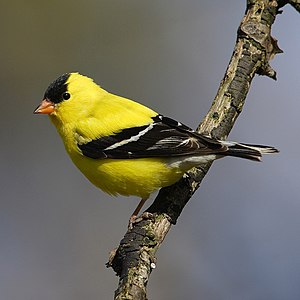 Image via Wikipedia
Image via Wikipedia
Wild Bird Seed For Backyard Use
By Barbara E. Volkov
Wild bird seed for our backyard use will entice more birds to our feeders. This bird seed can consist of a number of assorted seeds that will attract some unusual wild birds that come to our backyard. Many homeowners are enjoying bird watching today than ever before. We can use a few wild bird feeders and place different seeds in each one to invite more varieties of birds.
The seeds used depends on the type of birds we would like to see. Once we know what birds like which seeds we can determine how we want to use our birdfeeders. The following is a list of some of the seeds and which birds enjoy them for your convenience.
Black-oil sunflower seeds are considered as the number one best seller. Black-oil sunflower seeds are high in protein due to the amount of meat it contains. The outer shell is very soft for the smaller bird to handle. Our winged friends that enjoy this sunflower seed are the chickadees, finches, goldfinches, and nuthatches. The high oil content of this seed will keep the birds dry and warm in the cold winter months.
Striped sunflower seeds are not as popular as the black-oil seeds and are cheaper to purchase. The smaller birds usually find it harder to crack the harder shells of these seeds. The wild birds known to like this tougher seed are the blue jay, cardinal, and woodpecker.
Cracked corn seed is usually used to attract the larger bird species. Those that enjoy it are the eastern bluebirds, jays, pheasants, and some game birds. Using cracked corn all year in one of your bird feeders will probably attract some birds that do
not use some of the other feeders. Living in Southern California as I do, the smaller birds will eat everything except the cracked corn.
Millet is a large part of wild bird seed mixes because it is tiny and round. This feed is used is tubular feeders, hopper feeders, and tray feeders. Some of the backyard birds that enjoy millet are quail, juncos, sparrows, doves, buntings, bobwhites, and cardinals.
Thistle seed is a tiny black seed that is imported from Ethiopia and India and is also known as Nyjer seed. These seeds are so small it is better if you use them in a feeder that has wire mesh surrounding it. Some of the species that enjoy Nyjer seed include the house finch, purple finch, and goldfinch.
Safflower seeds are large seeds that have a white coating around it. They are often used instead of black-oil sunflower seeds because they will not attract the grackles, house sparrows, or starlings. The safflower seed attracts all the sames birds as the black-oil sunflower and will also attract the jay, titmouse, grosbeak, and cardinal.
Nuts that are used as bird seed are generally peanuts and peanut hearts. These nuts can be sold separately and are also found in some of the wild bird seed mixes. Some of the feathered friends that enjoy the nuts are cardinals, goldfinches, chickadees, nuthatches, mockingbirds, titmice, and woodpeckers.
Wild bird seed mixes usually consist of black-oil sunflower seeds, millet, striped sunflower seeds, and one or two other types of seed and they will attract most species of bird. They are available in most grocery stores, wild bird centers, and the wild bird suppliers at many pet centers.









![Reblog this post [with Zemanta]](http://img.zemanta.com/reblog_e.png?x-id=31b66823-c8ea-44c2-8b46-f76b389be434)
0 comments:
Post a Comment
Note: Only a member of this blog may post a comment.